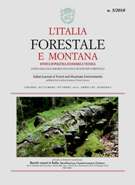Special section
Published 2013-05-16
Keywords
- forest ecosystems,
- epiphytic lichen diversity,
- biological indicators
Copyright (c) 2013 Italian Journal of Forest and Mountain Environments

This work is licensed under a Creative Commons Attribution-NonCommercial 4.0 International License.
Abstract
The role of lichens as indicators of environmental continuity is widely reported in central and northern European forests. Management plans consider them e.g. to predict thepresence of valuable species and for the selection of key woodland habitats. Nevertheless, effects of management to many forest-associated lichens in Mediterranean environments are poorly known and threats are only recently investigated.
Aim of this work is to contribute to the identification of lichen communities colonizing old-growth forests and variables influencing their diversity.
The study was carried out in two large forested areas in the high Molise region, belonging to the network identified under the PRIN 2007 “Metodi innovativi per la identificazione, caratterizzazione e gestione dei boschi vetusti in ambito Mediterraneo”. Abeti Soprani (Pescopennataro, Isernia) and Collemeluccio (Pescolanciano, Isernia) are the selected
stands because of their historical value and phytogeographical interest.
These stands represent two different habitat types: Abeti Soprani is a Southern Apennine silver fir forest and Collemeluccio a is mixed forest of silver fir and turkey oak.
The Lichen Diversity Values (LDV) was releved according to a randomized stratified sampling design within a plot of one hectare in each study area. The percentage contributions
to the total lichen diversity of each growth form, photobiont and reproductive strategy were taken into account in order to assess the differences among the plots.
The paper reports the results obtained during the first year of survey as a starting point for planning a long-term monitoring. The LDV seems to be very high in these Mediterranean
old-growth forests confirming their important role in lichen diversity conservation.

